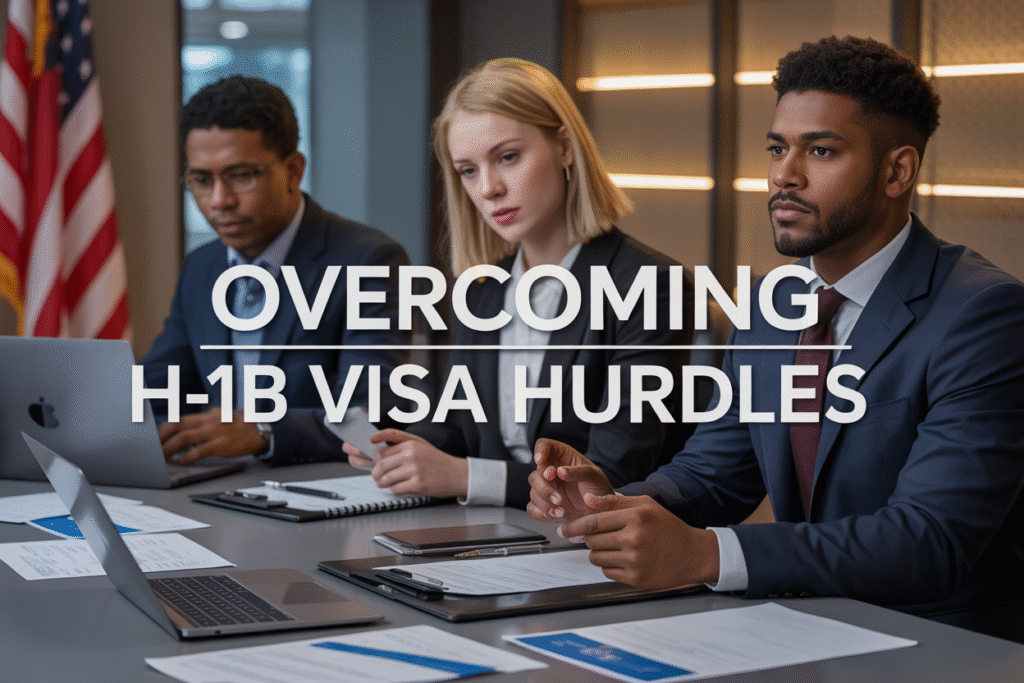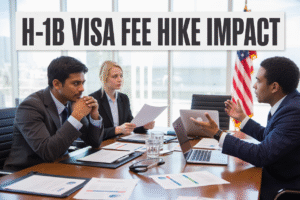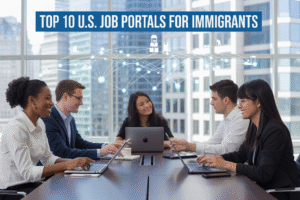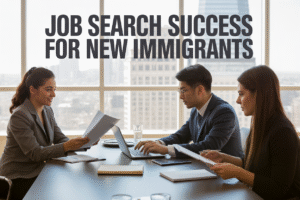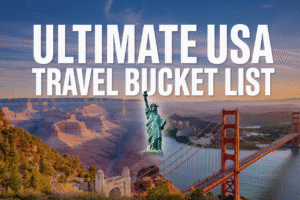The H-1B visa process has become incredibly competitive, with rejection rates soaring and countless qualified professionals facing repeated disappointments. If you’re an international student, skilled worker, or employer trying to navigate this complex system, you’re dealing with one of the most challenging immigration processes in the United States.
Who This Guide Is For:
This comprehensive breakdown is designed for international professionals seeking H-1B sponsorship, recent graduates planning their visa strategy, and employers who want to successfully sponsor foreign talent. Whether you’re facing your first application or recovering from a rejection, you’ll find actionable solutions here.
What We’ll Cover:
We’ll start by breaking down the H-1B cap challenges and lottery system that make approval so unpredictable, then dive into the financial and legal requirements that often catch applicants off guard. You’ll also discover strategic application preparation techniques that can significantly improve your chances, plus practical H-1B visa alternatives when the traditional route doesn’t work out.
The good news? While H-1B visa difficulties are real, understanding these hurdles and preparing properly can dramatically increase your success rate.
Understanding the H-1B Visa Cap System and Its Impact

Annual lottery system limits your chances to 30% or less
The H-1B visa lottery system represents one of the most frustrating aspects of the entire application process. Each year, USCIS accepts only 85,000 new H-1B petitions – 65,000 for the regular cap and an additional 20,000 for applicants with advanced degrees from U.S. universities. When demand consistently exceeds supply by 200-300%, your odds of selection drop dramatically.
Recent data shows selection rates hovering between 25-30% in most years, with some years dipping even lower. This means that even with a perfectly prepared application and willing employer sponsorship, you face a 70% chance of rejection through no fault of your own. The randomized selection process doesn’t consider your qualifications, salary, or the critical nature of your role – it’s purely a numbers game.
The lottery occurs in two stages: first, all 20,000 advanced degree slots are filled from that pool, then remaining advanced degree applications join the general pool for the 65,000 regular cap positions. This dual-lottery system creates additional complexity and uncertainty for planning your career timeline.
Many qualified professionals find themselves stuck in this cycle for multiple years, watching their career opportunities slip away while waiting for favorable lottery odds. The psychological toll of repeated rejections can be devastating, especially when you’ve invested years in education and building relationships with potential sponsors.
Advanced degree exemption provides only marginal improvement
The 20,000 additional slots reserved for advanced degree holders might seem like a significant advantage, but the reality proves more disappointing. While having a master’s, PhD, or equivalent degree from a U.S. institution does provide an extra opportunity, the improvement in odds remains relatively modest.
Advanced degree holders get two chances at selection – first in the 20,000 cap-exempt pool, then in the regular 65,000 pool if not selected initially. This dual opportunity typically increases selection chances from roughly 26% to about 35-40%, depending on the year’s application volume. While better than single-lottery odds, you’re still facing a 60-65% rejection rate.
The advanced degree exemption also comes with specific requirements that can trip up applicants. The degree must be from an accredited U.S. institution, and certain professional degrees may not qualify. Foreign degrees, even if equivalent or superior in quality, don’t count toward this exemption, creating an inherent bias in the system.
Many international students pursue advanced degrees partly hoping to improve their H-1B chances, only to discover the marginal benefit doesn’t justify the additional time and expense. The exemption helps, but it’s far from a guarantee of success.
Country-specific quotas create additional barriers for certain nationalities
While the H-1B lottery system doesn’t explicitly discriminate by nationality, per-country limits for employment-based green cards create a cascading effect that disproportionately impacts certain nationalities. Workers from India and China face the most severe challenges due to high application volumes from these countries.
Indian and Chinese nationals often encounter decades-long waits for green card processing, forcing them to continuously renew H-1B status year after year. This creates additional pressure on the H-1B cap system as these workers cannot transition to permanent residence, occupying H-1B slots that might otherwise become available for new applicants.
The country-of-birth quota system means that a software engineer from India might wait 50+ years for a green card, while someone with identical qualifications from a different country could receive permanent residence within 2-3 years. This disparity affects H-1B planning strategies and creates additional uncertainty for long-term career development.
Some employers hesitate to sponsor workers from heavily backlogged countries, knowing they’ll need to maintain H-1B sponsorship indefinitely rather than transitioning to green card sponsorship. This unofficial bias can limit job opportunities even for highly qualified candidates from affected countries.
| Country | Typical Green Card Wait | H-1B Impact |
|---|---|---|
| India | 50+ years | Severe – continuous renewals |
| China | 10-15 years | Moderate – extended renewals |
| Other countries | 2-3 years | Minimal – normal transition |
Understanding these systemic challenges helps explain why H-1B visa difficulties extend far beyond individual application quality or employer willingness to sponsor.
Financial and Legal Requirements That Create Barriers

Employer sponsorship costs exceed $10,000 in fees and legal expenses
Companies face substantial financial burdens when sponsoring H-1B applications, with total costs often reaching $10,000 to $15,000 per candidate. The basic USCIS filing fee alone costs $2,000, plus an additional $4,000 for employers with more than 50 employees where H-1B and L-1 workers comprise over 50% of the workforce. Most employers also pay attorney fees ranging from $3,000 to $7,000 for proper petition preparation and legal guidance throughout the H-1B application process.
These high sponsorship costs create a significant barrier for smaller companies and startups that might otherwise offer excellent opportunities to international talent. Many employers simply cannot justify the expense, especially when they’re uncertain about winning the H-1B lottery system. This financial reality means job seekers must target larger corporations with established immigration budgets, drastically limiting their employment options.
The situation becomes more challenging because these costs recur annually if the employee doesn’t secure permanent residence quickly. Smart job seekers research potential employers’ immigration policies beforehand and focus on companies that demonstrate consistent H-1B sponsorship commitment rather than first-time sponsors who might hesitate due to cost concerns.
Prevailing wage requirements limit job opportunities and salary negotiations
The Department of Labor’s prevailing wage system creates unexpected complications that restrict both job opportunities and earning potential. Employers must pay H-1B workers at least the prevailing wage for their specific role and location, which often exceeds what companies initially budgeted for positions. This requirement can eliminate job offers before they’re even extended, particularly for entry-level roles where prevailing wages might be higher than market rates.
Salary negotiations become virtually impossible under these constraints. Unlike other employees who can discuss compensation based on experience and skills, H-1B candidates face rigid wage floors that leave little room for flexibility. If a company’s budget doesn’t align with prevailing wage requirements, the opportunity disappears entirely.
The prevailing wage determination process also adds months to hiring timelines. Employers must obtain a Labor Condition Application before filing the H-1B petition, creating delays that many fast-moving companies won’t accommodate. This timing issue particularly affects competitive industries where top talent gets snapped up quickly, leaving H-1B candidates at a disadvantage compared to workers who don’t require sponsorship.
Maintaining valid status during application periods drains personal resources
The gap between graduation and H-1B approval creates a financial nightmare for many international students and workers. Those on F-1 student visas must carefully manage their Optional Practical Training (OPT) periods, often extending to STEM OPT to bridge the timing gap. This process requires additional fees, documentation, and constant status monitoring that adds stress and expense.
Workers transitioning from other visa categories face even more complex situations. They might need to maintain their current status through costly extensions while waiting for H-1B processing, which can take several months even with premium processing. These interim periods often involve restricted work authorization or complete inability to work, forcing individuals to drain savings while covering living expenses.
The uncertainty surrounding H-1B cap challenges makes financial planning nearly impossible. Applicants can’t predict if they’ll need backup plans, alternative visas, or whether they’ll face gaps in work authorization. Many end up paying for multiple applications, backup options, and extended stays that weren’t originally budgeted, creating significant personal financial strain during an already stressful process.
Premium processing fees add unexpected financial burden
The $2,805 premium processing fee catches many applicants off-guard, especially when combined with other H-1B application costs. While this service promises 15-day processing instead of several months, it’s become almost essential rather than optional due to tight timelines and employer expectations. Companies often require premium processing to meet project deadlines or hiring schedules, forcing candidates to absorb this additional cost.
The fee structure becomes particularly problematic when USCIS issues Requests for Evidence (RFEs) or denials that require resubmission. Each new filing cycle can trigger another premium processing fee if fast turnaround remains necessary. This creates a cascading financial burden where initial application costs multiply unexpectedly.
Budget-conscious applicants face difficult decisions between paying for premium processing or risking delayed approval that could jeopardize job offers. The timing pressures inherent in the H-1B system make this fee feel mandatory rather than optional, adding another layer of financial stress to an already expensive process that many international workers struggle to afford.
Timing Challenges That Derail Applications

April 1st filing deadline creates intense preparation pressure
The H-1B application process revolves around one of the most stressful deadlines in immigration law: April 1st. This single date determines whether you’ll have a chance at securing an H-1B visa for the following fiscal year. The pressure builds months in advance as both employers and applicants scramble to gather documentation, complete paperwork, and ensure everything meets USCIS requirements.
What makes this deadline particularly challenging is that it’s not just about having your documents ready. Your employer needs to have conducted the required recruitment process, obtained a Labor Condition Application (LCA) from the Department of Labor, and prepared detailed job descriptions that meet H-1B visa requirements. This entire process can take 2-3 months, meaning serious preparation must begin in January or February.
The April 1st rush creates additional complications when multiple employers want to sponsor the same candidate. Each application requires separate filing fees, legal costs, and administrative effort. Many qualified professionals find themselves watching potential opportunities slip away simply because employers couldn’t complete the preparation in time.
Missing this deadline means waiting an entire year for the next opportunity, creating a domino effect that impacts career progression, family planning, and financial stability.
October 1st start date forces career planning around rigid timelines
Even successful H-1B applicants face another timing hurdle: the mandatory October 1st start date. This inflexible timeline creates significant challenges for career planning and personal decisions. Unlike other visa categories that offer more flexibility, H-1B holders must begin their employment on this specific date, regardless of their current situation.
Current international students on Optional Practical Training (OPT) often find themselves in precarious positions. If their OPT expires before October 1st, they face a gap period where they cannot legally work in the United States. This gap can last several months, forcing many to return to their home countries and potentially lose job opportunities.
The rigid October start date also complicates employer planning. Companies must structure their hiring and project timelines around this date, sometimes holding positions open for months. This inflexibility can lead to employers withdrawing job offers or choosing to hire candidates who can start immediately rather than waiting for H-1B approval.
Personal life planning becomes equally challenging. Many H-1B applicants delay major decisions like marriage, home purchases, or advanced education enrollment because they cannot predict their employment status with certainty. The October deadline creates a binary outcome that leaves little room for alternative arrangements.
Multiple year wait times for many applicants delay life decisions
The most devastating timing challenge facing H-1B applicants is the multi-year wait that has become standard for many nationalities. Due to per-country limits and the H-1B cap challenges, professionals from countries like India and China face wait times extending 5-15 years or longer for permanent residency, creating prolonged uncertainty.
This extended timeline forces applicants into a holding pattern where major life decisions become impossible to plan. Starting a family, purchasing property, or making long-term career investments all carry additional risk when your legal status depends on annual lottery results and employer sponsorship.
The annual H-1B lottery system adds another layer of unpredictability. Even after multiple years of work in the United States, there’s no guarantee of selection in subsequent years. This uncertainty affects not just the primary applicant but their entire family, as spouses on H-4 visas have limited work authorization options and children may age out of dependent status.
| Challenge | Timeline Impact | Life Decision Affected |
|---|---|---|
| Initial lottery selection | 1-2 years uncertainty | Job search strategy |
| Annual renewals | 3-year cycles | Family planning |
| Green card processing | 5-15+ years | Home ownership, career changes |
| Dependent aging out | Child-specific deadlines | Educational planning |
Many professionals find themselves making suboptimal career choices to maintain H-1B status, staying with employers longer than desired or avoiding entrepreneurial opportunities that could jeopardize their immigration status. The psychological stress of this prolonged uncertainty often leads to decreased job performance and limited professional growth.
Employer-Related Obstacles You Must Navigate

Limited pool of willing sponsors reduces job market options
Finding an employer willing to sponsor your H-1B visa dramatically shrinks your potential job opportunities. Most companies avoid the H-1B sponsorship process due to its complexity, costs, and uncertain outcomes. The H-1B employer sponsorship requirement means you’re competing for positions at a fraction of available companies.
Small businesses and startups often can’t afford the legal fees and administrative burden that comes with sponsoring international workers. Even mid-sized companies frequently decide the risk isn’t worth the investment, especially when they can hire equally qualified domestic candidates without the paperwork hassle.
Tech giants like Google, Microsoft, and Amazon file thousands of H-1B applications annually, but they represent a tiny percentage of total employers. This concentration creates fierce competition for positions at sponsor-friendly companies, driving down salaries and increasing job requirements.
Company size and financial stability requirements eliminate opportunities
H-1B visa requirements include proving the employer can financially support the sponsored employee throughout their visa term. The Department of Labor scrutinizes company finances, tax records, and business stability before approving applications.
Companies must demonstrate:
- Consistent revenue streams over multiple years
- Sufficient cash flow to pay the prevailing wage
- Business continuity and growth projections
- Compliance with all tax obligations
| Company Type | Likelihood of Sponsorship | Common Obstacles |
|---|---|---|
| Fortune 500 | High | High competition, lengthy processes |
| Mid-sized (100-500 employees) | Medium | Budget constraints, limited HR resources |
| Small businesses (<100 employees) | Low | Cost prohibitive, administrative burden |
| Startups | Very Low | Uncertain finances, lack of sponsorship experience |
Newer companies or those with irregular revenue patterns often fail these financial stability tests, eliminating promising job opportunities even when the role perfectly matches your skills.
Industry-specific hiring practices favor certain sectors over others
Technology, healthcare, finance, and consulting dominate H-1B sponsorships, while creative industries, retail, hospitality, and non-profits rarely participate in the program. This uneven distribution forces many talented professionals to abandon their preferred career paths.
The H-1B application process requires positions to meet “specialty occupation” criteria, which inherently favors fields requiring specific technical degrees. Industries like:
- High sponsorship rates: Software development, data science, engineering, accounting
- Moderate sponsorship rates: Marketing (digital focus), project management, research
- Low sponsorship rates: Creative roles, sales, human resources, operations
Professional services firms often have established immigration teams and standardized processes, making them more likely to sponsor compared to traditional industries that view immigration as an occasional necessity rather than routine business practice.
Internal HR policies create additional screening barriers
Even companies that sponsor H-1B visas often maintain internal policies that create extra hurdles. Many require candidates to have advanced degrees from top-tier universities, previous work experience in the US, or connections to current employees.
HR departments frequently implement unofficial screening criteria that aren’t advertised in job postings:
- Minimum years of experience requirements that exceed job needs
- Preference for candidates already in the US on other visa types
- Requirements for specific certifications or educational backgrounds
- Internal referral systems that favor existing networks
Some companies maintain annual caps on H-1B sponsorships, meaning they stop considering international candidates once they’ve filed a certain number of applications. Others require candidates to work as contractors or interns first, creating additional financial and legal complications.
These H-1B visa difficulties extend beyond government regulations into corporate policies designed to minimize risk and administrative overhead, creating multiple layers of obstacles that candidates must navigate simultaneously.
Strategic Application Preparation Techniques

Building relationships with H-1B friendly employers increases success rates
Your best bet for securing H-1B employer sponsorship lies in targeting companies with proven track records of successful applications. Tech giants like Google, Microsoft, Amazon, and Apple consistently rank among the top H-1B sponsors, processing thousands of applications annually. These companies have dedicated immigration teams and streamlined processes that dramatically improve approval odds.
Research potential employers using the Department of Labor’s disclosure database to identify which companies regularly sponsor H-1B visas in your field. Look for organizations that sponsor multiple employees each year – this indicates they’re comfortable with the H-1B application process and willing to invest in international talent.
Start building relationships early through networking events, professional associations, and LinkedIn connections. Attend industry conferences where these employers actively recruit. Many H-1B friendly companies maintain university partnerships and recruit directly from campus career fairs.
Consider joining professional organizations relevant to your field. Many employers value candidates who demonstrate commitment to their profession through membership in industry groups. This networking approach often leads to referrals, which significantly increase your chances of getting noticed by hiring managers.
Optimizing your educational credentials maximizes lottery chances
Advanced degrees provide a substantial advantage in the H-1B visa lottery system. Master’s degree holders enter a separate lottery pool with better odds before joining the general lottery, effectively giving them two chances to win. This dual opportunity increases success rates from roughly 30% to approximately 50%.
If you hold a bachelor’s degree, consider pursuing a master’s program at a U.S. university. This strategy serves multiple purposes: you’ll qualify for the advanced degree lottery pool, gain additional time in the U.S. on a student visa, and potentially access STEM OPT extensions that provide extra work authorization.
Ensure your degree credentials are properly evaluated and translated. Use credential evaluation services recognized by USCIS to demonstrate how your foreign education equates to U.S. standards. This documentation proves your qualifications meet H-1B requirements and prevents delays during the application process.
Professional certifications in your field can strengthen your application profile. While they don’t replace degree requirements, certifications demonstrate specialized knowledge and commitment to professional development – qualities that appeal to H-1B sponsor employers.
Timing career moves to align with application cycles
The H-1B application process follows a strict timeline that requires careful planning. Applications open in early April, but preparation should begin months earlier. Smart candidates start job searching in the fall preceding the application year, allowing sufficient time to secure offers and complete documentation.
Plan your graduation and job search timeline strategically. If you’re completing a degree program, aim to finish by December or spring semester. This timing allows you to start working immediately after graduation while your employer prepares your H-1B application for the following April filing period.
Consider the gap between H-1B lottery results and status activation. Even if selected in the lottery, your H-1B status doesn’t begin until October 1st. Plan for this transition period, especially if your current status (like F-1 OPT) expires before then. Some candidates need to maintain legal status through other means during this gap.
If you’re already working in the U.S. on a different visa, coordinate with your employer about timing your H-1B application. Some employers prefer to file immediately when you become eligible, while others may want to evaluate your performance first.
Preparing comprehensive documentation prevents costly delays
Thorough documentation can make or break your H-1B application. Start gathering required documents well before the April filing period. Key documents include your degree certificates, transcripts, professional licenses, and detailed employment letters outlining your job duties and qualifications.
Create a comprehensive portfolio that clearly demonstrates the connection between your education, experience, and proposed job role. USCIS officers need to see how your background qualifies you for the specific position. Include detailed job descriptions, organizational charts, and project examples that showcase your specialized knowledge.
Work closely with your employer’s immigration attorney to ensure all paperwork is complete and accurate. Even minor errors can trigger requests for evidence (RFEs) that delay processing and reduce approval chances. Double-check all forms for consistency – discrepancies between different documents often raise red flags.
Maintain organized digital and physical copies of all documents. Immigration cases can span months or years, and you may need to reference or resubmit documentation multiple times. A well-organized filing system saves time and prevents stress when urgent requests arise.
Consider preparing additional supporting evidence beyond minimum requirements. Letters from colleagues, clients, or industry experts explaining your specialized skills can strengthen your case. Academic publications, patents, or professional achievements demonstrate exceptional ability and can differentiate your application from others.
Alternative Visa Pathways When H-1B Fails

O-1 visa leverages extraordinary ability for immediate approval
The O-1 visa offers a compelling H-1B visa alternative for individuals with exceptional abilities in sciences, arts, education, business, or athletics. Unlike the H-1B lottery system, O-1 visas have no annual cap, providing immediate processing opportunities for qualified candidates. This pathway requires demonstrating extraordinary ability through substantial evidence such as awards, published materials, high salary, or recognition from peers in your field.
To qualify, you need at least three of eight specific criteria, including receiving major awards, membership in associations requiring outstanding achievements, or having your work featured in professional publications. The application process typically takes 2-4 months, significantly faster than H-1B processing timelines. Tech professionals often qualify through patents, speaking engagements at major conferences, or leadership roles at prominent companies.
L-1 visa utilizes international company transfers
The L-1 visa serves multinational companies transferring employees to US offices, branches, or subsidiaries. This option works particularly well for professionals working at companies with international presence. L-1A covers managers and executives, while L-1B applies to specialized knowledge workers.
Key requirements include working for the overseas company for at least one year within the past three years and transferring to a related US entity. The relationship between companies must be parent-subsidiary, branch office, or affiliate. L-1 holders can eventually apply for permanent residence without affecting their status, and spouses receive work authorization through L-2 dependent visas.
Investment-based visas provide entrepreneur alternatives
Investment visas offer pathways for entrepreneurs and investors seeking US work authorization. The E-2 treaty investor visa requires substantial investment in a US business, typically starting at $100,000-$200,000 depending on the business type and location. E-2 holders can work only for their investment enterprise but can renew indefinitely as long as the business remains viable.
The EB-5 immigrant investor program requires minimum investments of $800,000 in targeted employment areas or $1.05 million elsewhere, creating at least 10 full-time jobs. While expensive, EB-5 provides direct permanent residence for investors and their families.
| Visa Type | Investment Amount | Work Authorization | Processing Time |
|---|---|---|---|
| E-2 | $100K-$200K+ | Own business only | 2-4 months |
| EB-5 | $800K-$1.05M | Unrestricted | 12-24 months |
Advanced degree programs offer extended OPT opportunities
Students pursuing advanced degrees can access extended Optional Practical Training periods, providing additional time to secure H-1B sponsorship. STEM graduates receive 36 months of OPT (12 months standard plus 24-month extension), while other fields get 12 months. This extended timeline allows multiple H-1B lottery attempts.
Consider pursuing relevant master’s degrees or professional certifications in STEM fields to qualify for extended OPT. Many universities offer one-year master’s programs specifically designed for working professionals. Some institutions also provide pathway programs combining academics with practical training, maximizing your chances of finding H-1B employer sponsorship during extended work authorization periods.
The key lies in strategic timing – starting your program to align OPT periods with H-1B application seasons maximizes your lottery opportunities while maintaining legal work status.
Long-Term Career Planning Beyond Initial Approval

Green card application strategy prevents future visa dependencies
Securing an H-1B visa is just the beginning of your journey toward permanent residency in the United States. Smart professionals start their green card process immediately after H-1B approval, even if they’re not ready to commit permanently. The EB-1, EB-2, and EB-3 categories offer different paths based on your qualifications and circumstances.
Your employer can file a PERM labor certification while you’re on H-1B status, which typically takes 12-18 months to process. During this time, you’re building priority dates that matter significantly for certain countries with backlogs. Starting early means you won’t face the anxiety of H-1B renewals running out before your green card arrives.
Consider the I-140 premium processing option when available. This accelerates the petition review to 15 days and provides crucial employment authorization document (EAD) eligibility for you and your spouse. The EAD removes many H-1B restrictions and gives you job mobility between employers without losing your green card application progress.
Country-specific backlogs affect timing dramatically. Indian and Chinese nationals often wait years longer than other countries, making early filing essential. Track visa bulletin updates monthly and plan accordingly – your priority date determines when you can file for adjustment of status.
Maintaining status during transitions protects your investment
H-1B status maintenance requires careful attention to employment details, travel documents, and renewal timing. Any gap in authorized employment can jeopardize your entire immigration investment and force you to restart the process from scratch.
Keep meticulous records of your I-94 entries and exits, pay stubs, and employment letters. USCIS increasingly scrutinizes H-1B holders during renewals and green card applications. Document every business trip, vacation, and employment change with official paperwork.
Plan H-1B renewals at least six months before expiration. Processing delays happen frequently, and premium processing isn’t always available. Your employer needs time to gather supporting documents, and you need buffer time for potential Requests for Evidence (RFEs) that could delay approval.
Bridge any employment gaps carefully. The 60-day grace period after H-1B termination gives you limited time to find new sponsorship or change status. Don’t assume this grace period resets with each new employer – accumulated out-of-status time can trigger removal proceedings.
Travel requires valid documentation every time you leave the United States. Your H-1B approval notice, valid passport, and current employment verification letter are non-negotiable. Expired visas don’t prevent reentry if your I-94 and status remain valid, but consular processing might be required for visa stamp renewal.
Building portable skills reduces employer dependency risks
H-1B dependency creates career vulnerability that smart professionals actively counter by developing transferable expertise and professional networks. Your skills should transcend any single employer’s specific systems or proprietary processes.
Focus on industry-standard technologies, methodologies, and certifications that multiple employers value. Software engineers benefit from mastering popular programming languages, cloud platforms, and development frameworks used across companies. Finance professionals should pursue CFA, FRM, or similar globally recognized credentials that demonstrate portable expertise.
Document your achievements quantitatively to support future H-1B transfers or green card applications. Track project outcomes, cost savings, revenue generation, and process improvements you’ve driven. These metrics become essential for Labor Condition Application (LCA) justifications and EB-2 or EB-1 petitions.
Build relationships beyond your immediate team and company. Professional associations, industry conferences, and alumni networks provide job opportunities that might not require extensive H-1B transfer processes. LinkedIn presence and thought leadership content establish your expertise publicly and attract recruiters from H-1B-friendly employers.
Develop side projects or consulting opportunities within H-1B regulations. While you cannot work for other employers without authorization, you can create intellectual property, contribute to open-source projects, and build expertise that demonstrates your value to potential sponsors.
Consider entrepreneurial paths early in your H-1B journey. The O-1 visa rewards extraordinary ability, while E-2 treaty investor status might suit business-minded professionals from qualifying countries. These alternatives require different skill sets and documentation than traditional employment-based options.

The H-1B visa process presents significant challenges, from the unpredictable cap system to strict financial requirements and tight application deadlines. Employer sponsorship adds another layer of complexity, as does navigating the legal requirements that can make or break your application. These hurdles might seem overwhelming, but they’re not impossible to overcome with the right preparation and strategy.
Success comes down to understanding each obstacle and having backup plans ready. Start your application preparation early, work closely with experienced immigration attorneys, and don’t put all your hopes on just the H-1B route. Explore alternative visa options like the O-1 or L-1, and think about your long-term career goals beyond that first approval. The key is staying informed, being strategic, and remaining flexible as immigration policies continue to evolve.


